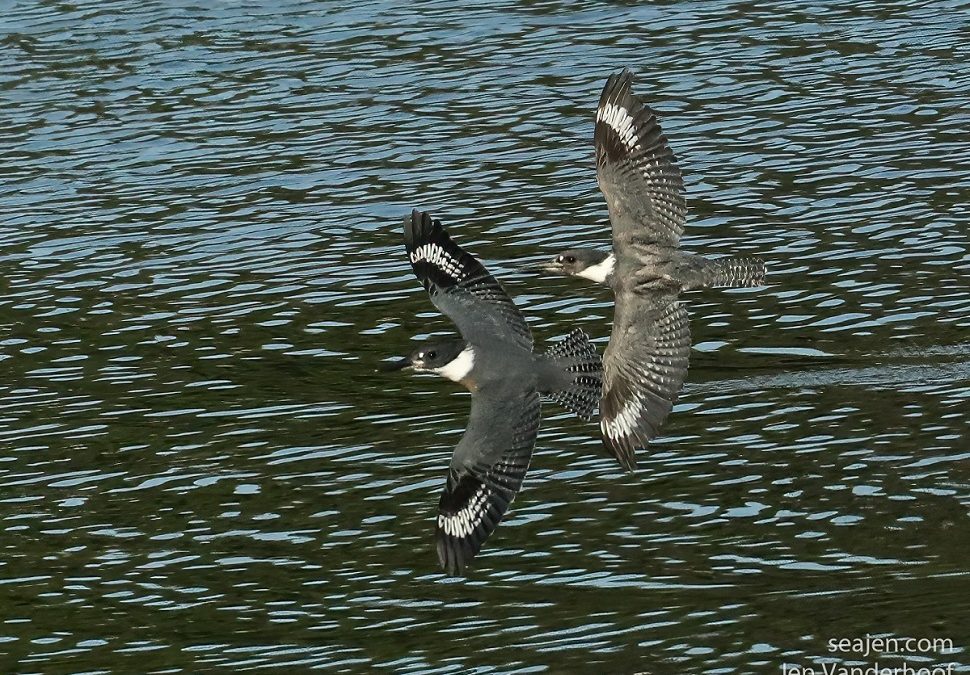It was a bright late-July day in Dockton Park, just days before a bulkhead removal slated to slip perfectly between the tides to avoid backhoe damage to sensitive nearshore habitat. The heavy machinery was commissioned and a team of five had cleared their schedules to ensure the job would be finished before a cycle of higher daytime tides could delay it for another month or more.
Vashon Nature Center (VNC) director Bianca Perla and staff member Adrian Swain along with college intern Tabitha Gray and high-school volunteer Quinn Williams were enjoying a warm, breezy afternoon as they conducted a monitoring survey as part of BeachNET, a long-term VNC beach bulkhead research project measuring the health of forage fish habitat critical to salmon health. Osprey whistled high overhead and tree branches rustled in the slight breeze. Vashon-Maury beaches are a key regional resource attracting salmon from all over Puget Sound that feed, rest, and grow along our shorelines. Their diet includes insects that fall from overhanging branches, and the VNC team was there to measure insect abundance and type.
Before the herring stock began a downward trend in 2006, Dockton eelgrass beds were the island’s most prolific herring spawning grounds. Juvenile Chinook and other salmon rely on Vashon-Maury’s shoreline—the least armored in the county—and young salmon inhabit even the farthest reaches of Quartermaster Harbor.
As the VNC crew conducted the shoreline “before” survey, they noticed a small hole in the shore bank. It looked like the entrance to a Belted Kingfisher nest, though it was situated unusually low for such a cavity, just over six feet off the ground. (Belted Kingfishers use strong, clawed, baseball-glove like feet to dig 3- to 6-foot upward-sloping tunnels that end in a chamber where they brood their eggs.) Curious, they approached and were surprised to hear insistent chirps indicating it was still an active nest!

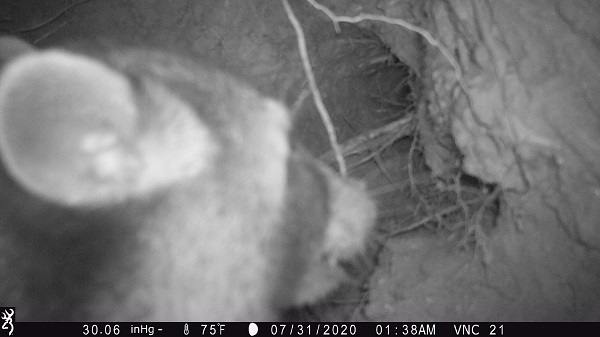
Photo: VNC WildCam capture
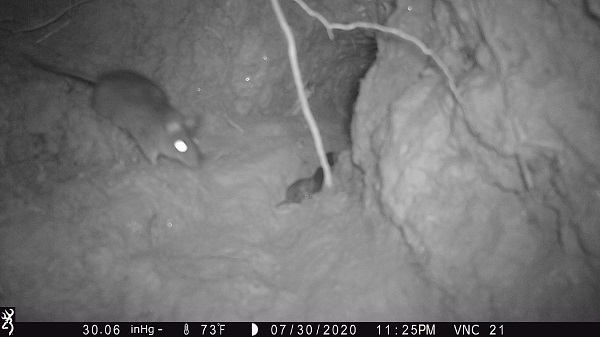
Perla immediately alerted Greg Rabourn, Vashon-Maury Island steward for King County, and he contacted Jo Wilhelm, county manager of the poised-to-launch bulkhead removal project. All involved agreed that the work would not begin until the birds had fledged. In addition to regular on-site observations by Rabourn and a county ecologist, Perla loaned them one of VNC’s wildlife cameras as an additional “eye” on the nest. The motion-sensitive device snapped photos of adults coming to feed the nestling (it turned out that just one bird remained in the nest), and of the young bird approaching the burrow entrance. What started out as due-diligence to protect wildlife (it would be ironic to remove a bulkhead to improve fish habitat only to kill fish-reliant birds in the process), brought county staff together as they cheered the hatchling on through shared photos of its progress. The images also provided rare glimpses of the trials of rearing young in the wild.
“I don’t know that we would have caught the existence of this burrow because of where it was located without their help and I’m very appreciative of them making the discovery,” Rabourn says. “I’m used to seeing Kingfisher holes up higher on big bluffs and would not have thought to look below the ferns so low down. That was an eye-opener for me. I’m grateful to them for discovering the nest and for loaning us the camera and their expertise with it.”
The camera was up for nearly a month and captured images of predators nosing around the nest, snapped an adorable first “baby picture” of the nestling, and got remarkable shots of the young bird’s first launch into flight.


“All we wanted to do was figure out when the nestling fledged, but we learned so much more,” Perla says. “We learned how much a kingfisher family has to deal with during nesting—raccoons visited frequently trying to get inside the burrow, and rodents visited as well. It was really cool to get a better understanding of the nesting life of Belted Kingfishers.”
County protocol is to send in an expert to review the situation when nesting birds are found on a project site. Jen Vanderhoof, a King County wildlife ecologist, master birder and beaver expert, gets called in on anything wildlife related, including bird nest surveys. She doesn’t get “bird assignments” as often as she’d like, so she was excited to visit the Dockton nest. What could have been a routine check in a project report, took an interesting turn when Vanderhoof noticed something peculiar about this particular kingfisher family.
In addition to the adult pair of Belted Kingfishers caring for and teaching 2−3 fledged young to fish, there was an unfledged nestling in the burrow requiring frequent fish deliveries. What still makes Vanderhoof scratch her head, and for which she has (as of yet) to find corroboration for in scientific literature, is that the two adults were seemingly tending chicks of varying ages with completely different needs at the same time.
“Discovering something unusual was so exciting,” says Vanderhoof, who details her observations of the birds’ unusual behavior in this memo. “A first I was completely confused because what I was seeing didn’t make sense. As I dug into it I thought, this is fascinating, and I don’t know if it’s been reported anywhere.”
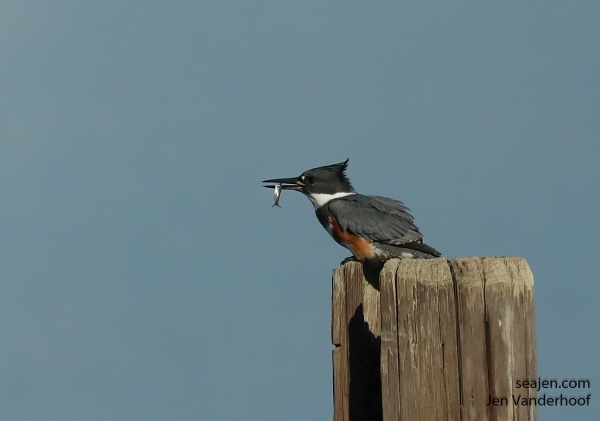
She has read myriad research papers and followed many leads around the state and country in search of a kingfisher expert to reflect on her observations. So far, she has hit dead-ends. One of her major takeaways from the experience is to never make assumptions when it comes to nature.
“You never know what you’re going to see and there’s so much we don’t know. I tell myself when I go out birding that even if it’s a quiet day, there’s always at least one amazing thing I’ll see,” Vanderhoof says. “This experience is a good reminder to stop and pay attention and then try to figure out what you saw.”
This story has a happy ending, well, actually two. The young kingfisher successfully fledged on Aug. 9, and the county was able to begin the Dockton bulkhead removal project under ideal tide conditions, even finishing five weeks early despite the two-week delay. (Check out this fun time-lapse video of the entire project.) Rabourn, who has been part of more than six island bulkhead removals since 2010, finds it rewarding to see nature reclaim a beach.
“It’s amazing how quickly the shoreline changes once you remove the human-made impediment to the natural processes,” Rabourn says. “The bulkhead is preventing wave erosion and it’s surprising how quickly nature restores the natural shoreline once the armoring is gone. You start to see new sediment on the beach and new plants established within months.”
As a case-in-point, shoreline alders cut as part of the Dockton bulkhead removal are already playing their new role in the shoreline ecosystem.
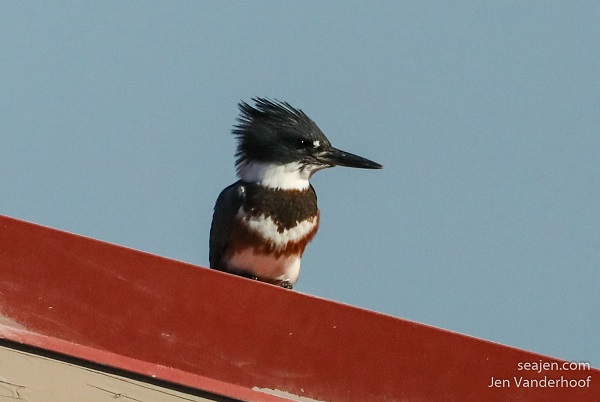
“Wherever those big trees fall into the water they attract fish and become great habitat areas for herons and kingfishers,” Rabourn says. “One of our onsite project folks was out there later in the summer and thinks he saw the same kingfisher fledgling practicing hovering and fishing right off the project site. We waited for it to fly, and there it was, taking the next steps learning how to hunt for its own food.”
This bulkhead removal project was primarily funded by the Washington State Department of Fish and Wildlife Estuary and Salmon Restoration Program.
Banner image caption: Two Belted Kingfishers flying in tandem, a common sight during July and August visits to the Dockton nest. In most if not all cases, these flying duets were composed of an adult and juvenile bird. Juveniles have darker plumage because it hasn’t yet faded due to wear and sunlight; in this photo the juvenile is flying out front. Photo: Jen Vanderhoof

